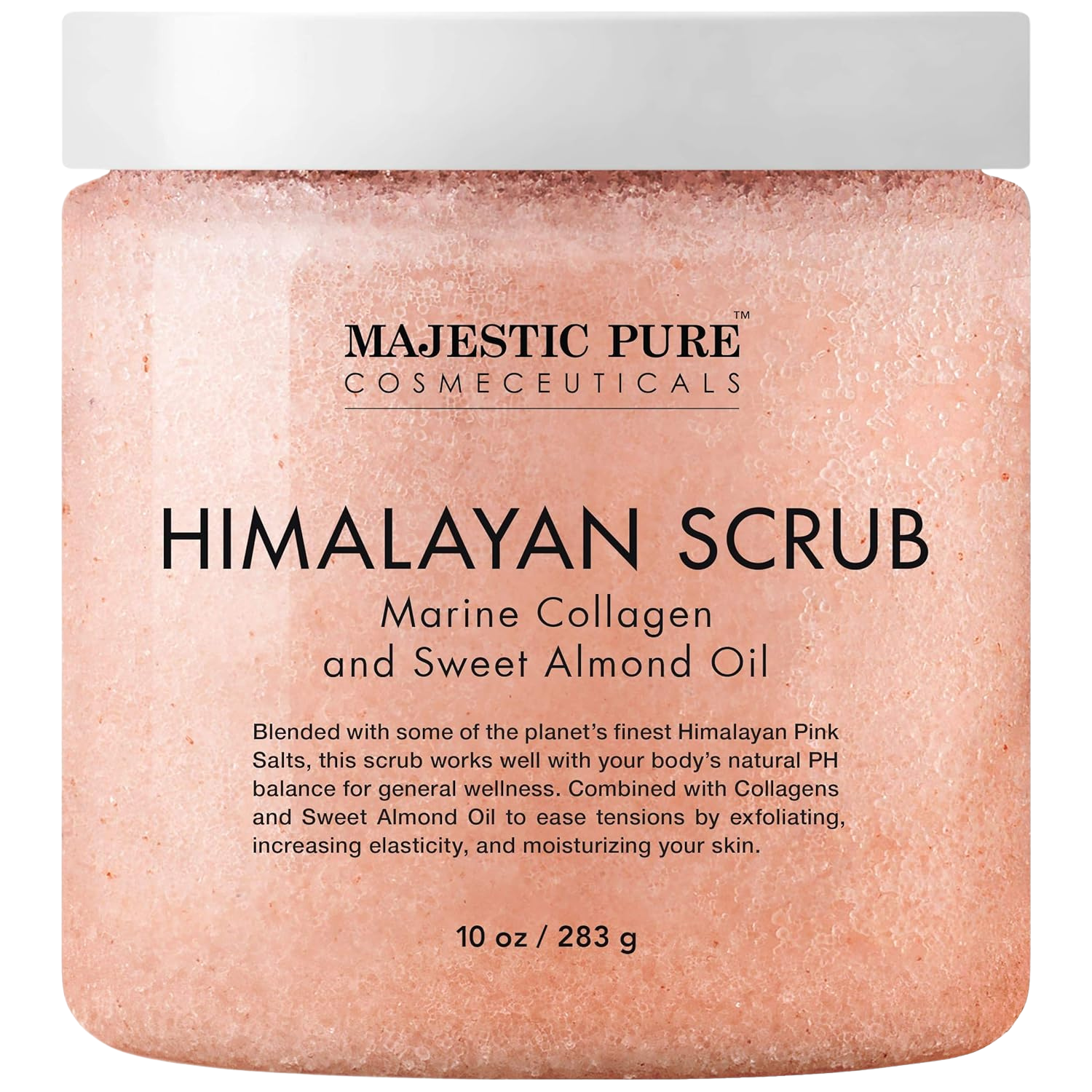Introduction and Quick Summary
Japanese Curry Udon is a delightful dish that combines the richness of Japanese curry with the chewy goodness of udon noodles. If you’re looking for a quick and easy weeknight dinner that packs a punch of flavor, this recipe is perfect for you. Not only does it come together in about 30 minutes, but it also uses simple ingredients that you may already have in your pantry. The best part? This meal is completely customizable! You can add your favorite vegetables or proteins to suit your taste.
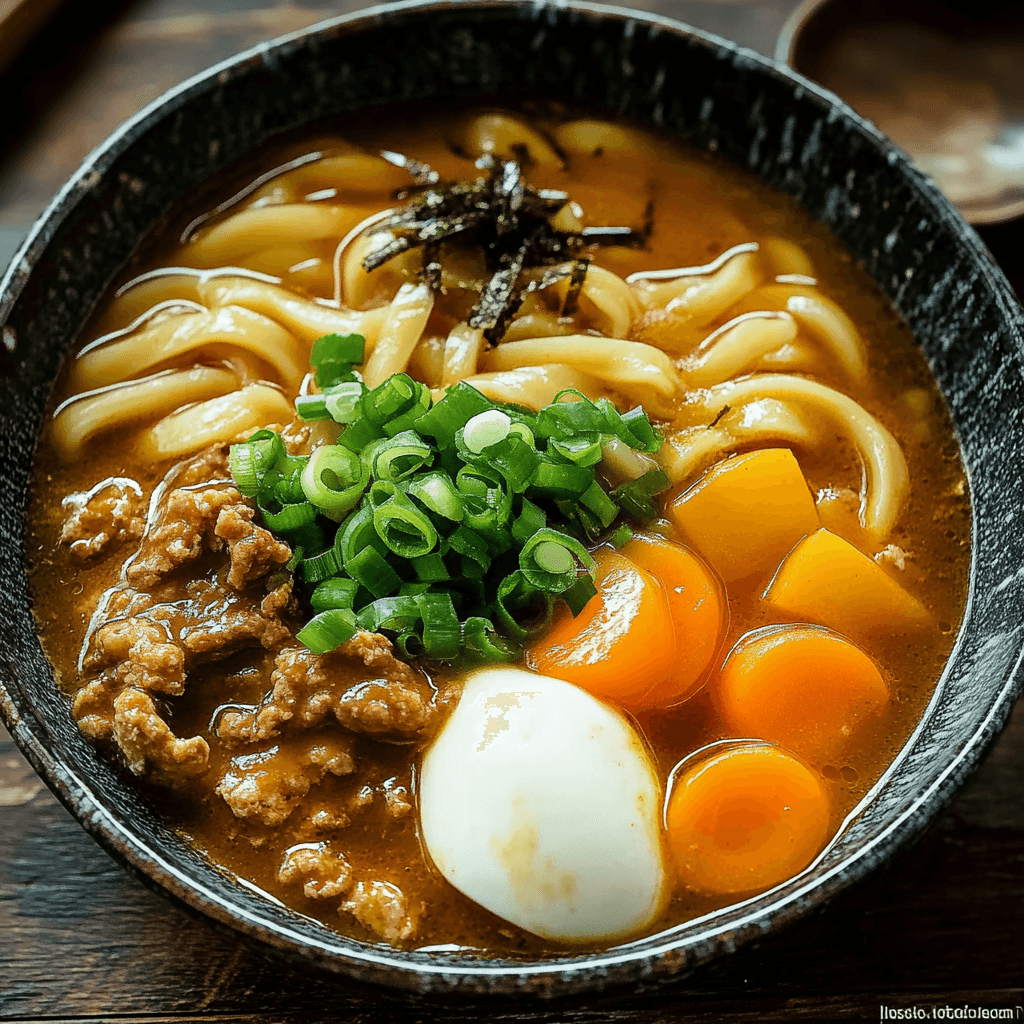
The aromatic spices of curry combined with the comforting texture of udon create an unforgettable experience. Whether you’re cooking for yourself or feeding a family, this dish is sure to please everyone at the table. In this article, we will take you through all the necessary steps to prepare this delightful dish at home. From choosing the right ingredients to step-by-step preparation instructions, you’ll find everything you need to whip up this culinary delight. So let’s dive into the world of Japanese Curry Udon and discover how easy it can be to create restaurant-quality meals at home!
Main Ingredients
Udon Noodles
Udon noodles are thick wheat flour noodles that provide a satisfying chewiness. For this recipe, you will need 400 grams of fresh or frozen udon noodles. Fresh udon noodles are typically found in the refrigerated section of Asian grocery stores. If using frozen noodles, cook them according to package instructions before adding them to your curry sauce. Their thick texture holds onto flavors beautifully, making them an excellent choice for soaking up the rich curry sauce.
Japanese Curry Roux
A key component of this dish is the Japanese curry roux, which comes in blocks or packets and is available at most Asian grocery stores. You will need 100 grams of curry roux for this recipe. The roux provides depth and richness to your dish with its blend of spices like turmeric, cumin, and coriander. There are various brands available; choose one that suits your taste preferences—mild or spicy—to achieve your desired heat level.
Vegetables
For added nutrition and flavor, you should include 2 cups of mixed vegetables such as carrots, potatoes, and bell peppers. Chop these vegetables into bite-sized pieces to ensure even cooking. Carrots add sweetness while potatoes provide creaminess as they soften during cooking. Bell peppers contribute a nice crunch and vibrant color that elevates the presentation of your dish.
Protein
You can choose any protein you prefer; however, chicken breast works wonderfully in this recipe. Use about 300 grams of boneless chicken breast cut into small pieces for faster cooking time and better flavor absorption. Alternatively, tofu or shrimp can also be used if you prefer a vegetarian or seafood option. Ensure that any protein is cooked thoroughly before mixing it into the curry sauce.
Broth
Using broth enhances the depth of flavor in your Japanese Curry Udon. You’ll need about 4 cups of chicken or vegetable broth for this recipe. The broth acts as the base for your curry sauce and adds complexity while complementing the other ingredients. Opting for low-sodium broth allows you more control over salt content while still delivering robust flavor.
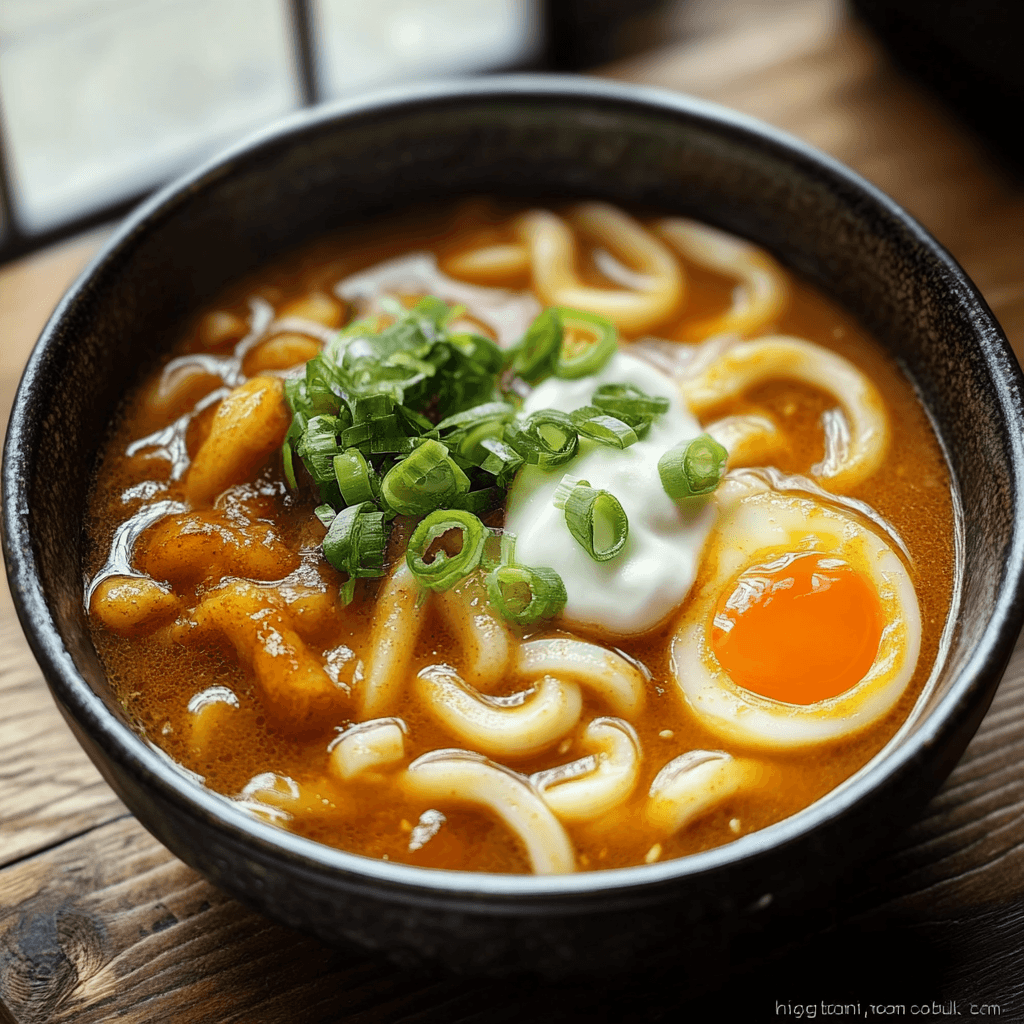
How to Prepare Japanese Curry Udon (Quick and Easy Weeknight Dinner)
Step 1: Prepare Ingredients
Begin by gathering all your ingredients on a clean surface. Wash and chop your mixed vegetables into bite-sized pieces; this ensures they cook evenly within the sauce later on. If using fresh udon noodles, boil them according to package directions until just tender but still firm (al dente). Drain under cold water and set aside; if using frozen udon noodles, follow similar instructions based on package guidelines.
Next, cut the chicken breast into small pieces—this helps with quick cooking—and season lightly with salt and pepper if desired. By preparing everything beforehand—also known as “mis en place”—you streamline your cooking process significantly.
Step 2: Cook Chicken
In a large pot or deep skillet over medium heat, add about two tablespoons of oil—vegetable oil works well here—and allow it to heat up slightly before adding chicken pieces into the mix evenly spaced out within the pan so they sear rather than steam.
Cook them for roughly 5 minutes or until golden brown on one side before flipping them over gently with tongs or a spatula—this ensures they don’t break apart too much during cooking! Brown all sides evenly until fully cooked through (internal temperature should reach 165°F/75°C). Once done remove from pan onto plate lined with paper towels to absorb excess grease temporarily before moving onto next steps.
Step 3: Add Vegetables
With the same pan still warm from cooking chicken (adding extra flavor), toss in chopped mixed vegetables including carrots first since they take longer than others; stir-fry these around for around three minutes until they begin softening slightly but still retain some crunchiness.
Follow up by adding potato cubes next—a few minutes later when carrots show signs softness-add bell peppers last since they require minimal time compared! Continue stirring mixture continuously ensuring nothing sticks too much while allowing natural sweetness develop during sautéing phase without burning any bits at bottom either! After about six-seven minutes total cooking time has elapsed when all veggies look vibrant yet tender-remove from heat briefly then move onto next stage quickly!
Step 4: Create Sauce
Now it’s time we build our flavorful sauce! Pour four cups of chosen broth back into same heated pan along with pre-measured block(s)of curry roux crumbling them directly inside liquid mixture essentially letting heat help dissolve those cubes effortlessly creating luscious creamy consistency!
Stir together thoroughly until fully combined ensuring no lumps remain visible—it should turn dark brownish hue at end product! Adjust seasoning levels (salt/pepper) according personal preference now before returning previously cooked chicken plus sautéed veggies back into hot bubbling sauce allowing everything mingle harmoniously over moderate-low flame covering lid partially while simmering gently around ten-fifteen minutes maximum duration being cautious not burn anything down below!
Step 5: Combine Noodles
After simmering period has elapsed remove cover revealing wonderful aromas wafting throughout kitchen! Gently fold cooled prepared udon noodles straight into delicious bubbling pot ensuring every strand gets coated nicely within rich gravy-like consistency created earlier during cooking process seamlessly bringing together textures flavors found within each bite.
Toss mixture carefully avoiding mushy outcomes simply allowing noodles absorb flavors present throughout dish itself! Cover lid again briefly allowing remaining moisture lock-in properly so as not dry-out completely whilst keeping warm until ready serve up heaping bowls just right amount per person!
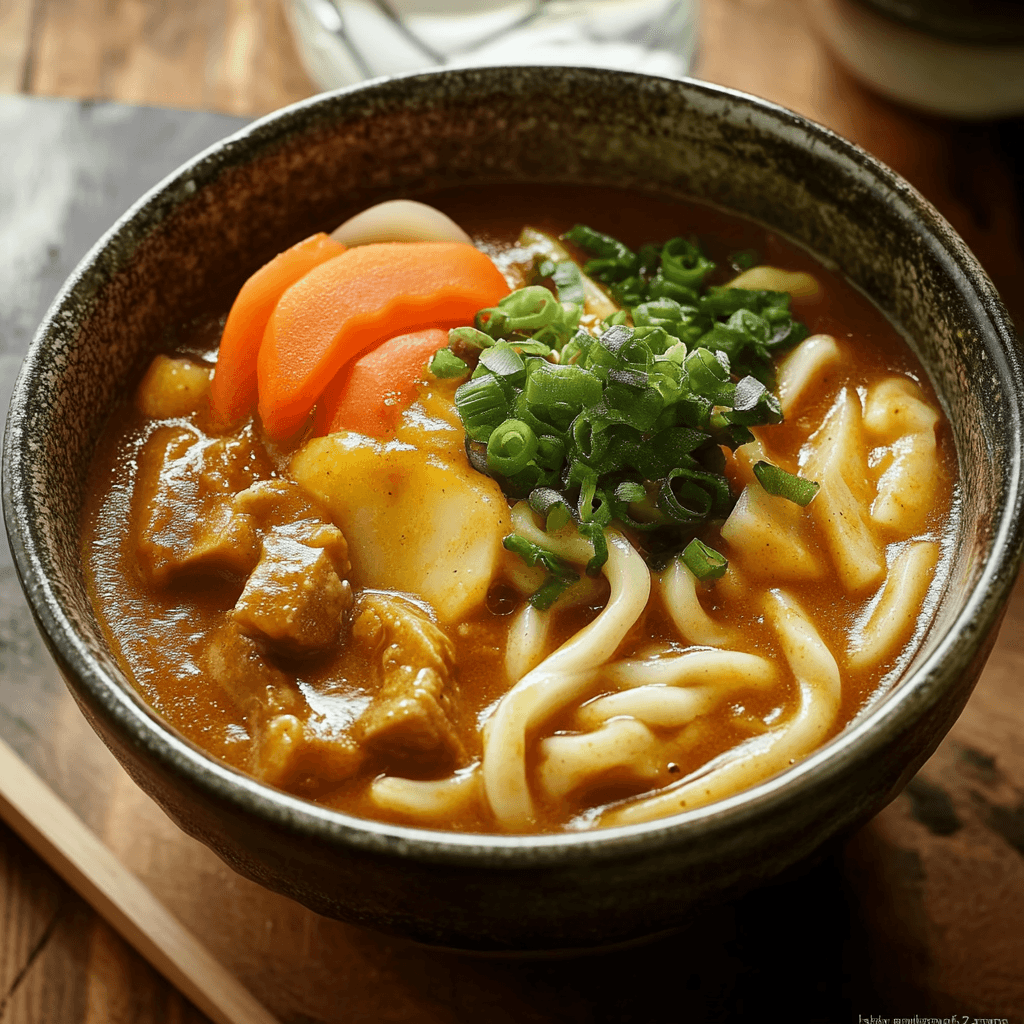
Serving and Storing Tips
Serving Suggestions
To serve your delightful Japanese Curry Udon effectively present each bowl filled generously garnishing top fresh chopped green onions—scallions—or cilantro sprigs elevating visual appeal alongside slight drizzle sesame oil enhancing fragrance further more appealing overall appearance too!
Pair alongside pickled ginger slices providing contrasting tang juxtaposed against savory profile found within curry itself! This combination adds delightful contrast making every mouthful memorable beyond belief bringing authentic experience reminiscent dining-out experiences straight home kitchen itself without breaking bank account doing so either!
Consider offering additional side dishes such as steamed rice prepared plain keeping things simple yet filling overall especially if serving larger crowds where everyone craving something hearty warming comfort-food style essence embodies perfectly fitting choice across board regardless dietary restrictions/preferences!
Storing Leftovers
If there happen fortunate enough leftovers after enjoying meal don’t fret—they store well too! Allow cooling down slightly before transferring portions leftover containers sealing tightly preventing air exposure extending freshness lifespan thus maintaining quality longer possible duration!
Refrigerated leftovers usually last three-four days max so ensure consume timely manner enjoying flavors intact throughout entire span storage period safely kept away common contaminants potentially ruining good food experience enjoyed previously made deliciously crafted dish thoughtfully prepared initially gathered ingredients together fulfilling expectations set high prior diving inside culinary journey embarked upon earlier today together collectively working towards success achieved ultimately completing vision realized completely satisfying manner indeed overall satisfaction guaranteed without doubt whatsoever!
Mistakes to avoid
When making Japanese Curry Udon, it’s easy to fall into some common pitfalls. Here are key mistakes to avoid for a successful dish.
Using the wrong type of noodles can dramatically affect the texture and flavor of your dish. Udon noodles are thick and chewy, which is essential for a satisfying bite. If you substitute with other types of noodles, such as spaghetti or ramen, the overall experience will suffer. Always choose fresh or frozen udon noodles if possible; they’re more authentic and provide the best consistency.
Another mistake is skimping on the seasoning. The heart of Japanese curry is its rich, savory sauce. Using pre-packaged curry roux can save time, but omitting additional seasonings like garlic, ginger, or soy sauce can lead to blandness. Be sure to taste as you go and adjust flavors accordingly. A pinch of salt or a dash of spice can elevate your udon to restaurant-quality.
Overcooking the vegetables is another frequent error. Tender-crisp veggies not only add flavor but also provide a pleasant contrast in texture against the chewy udon noodles. Aim to sauté them just until they are vibrant and slightly tender. Remember that they will continue cooking when mixed with the hot sauce.
Finally, neglecting garnishes can rob your dish of visual appeal and freshness. Green onions, sesame seeds, or even a drizzle of chili oil can enhance both presentation and taste. These simple additions make your meal look more appealing and offer an extra layer of flavor that complements the curry perfectly.
Avoiding these mistakes will help you create a delightful Japanese Curry Udon that impresses family and friends alike.
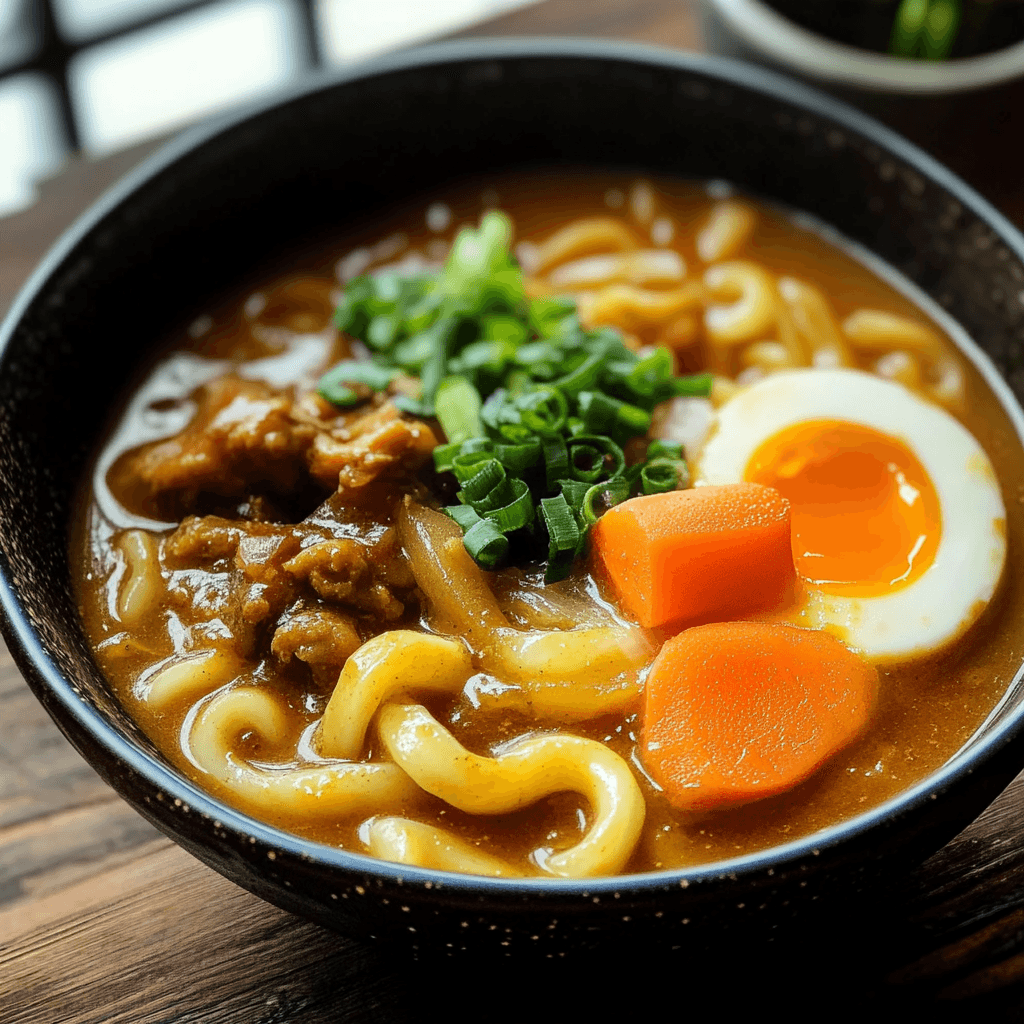
Tips and tricks
Mastering Japanese Curry Udon involves not just avoiding mistakes but also embracing helpful tips for a stellar outcome.
First, prep all your ingredients before starting to cook. This mise en place technique ensures you have everything at hand when needed, making the cooking process smooth and efficient. Chop your vegetables into uniform pieces so they cook evenly. Having your udon noodles boiled ahead of time allows you to focus on creating a rich curry sauce without worrying about timing everything perfectly.
Next, consider using homemade broth instead of water for added depth in flavor. A simple dashi or chicken broth brings umami notes that enhance the overall dish. If you’re short on time, store-bought broth works too—just be sure it’s a high-quality option without excess sodium.
Utilizing aromatics like onion, garlic, and ginger can significantly elevate your curry’s flavor profile. Sauté these ingredients first before adding anything else; this releases their natural oils and intensifies their flavors in your dish. Don’t rush this step; allow them to become fragrant for maximum impact.
Additionally, experiment with toppings! While sliced green onions are traditional, don’t hesitate to explore different garnishes such as pickled ginger or nori strips for an unexpected twist. These additions not only boost flavor but also make your bowl visually enticing.
Lastly, remember that practice makes perfect! The more often you whip up this dish, the better you’ll get at balancing flavors and perfecting techniques. Embrace trial and error; each attempt teaches you something new about crafting delicious Japanese Curry Udon.
Suggestions for Japanese Curry Udon (Quick and Easy Weeknight Dinner)
To create an outstanding Japanese Curry Udon experience at home, consider these thoughtful suggestions that enhance both preparation and enjoyment.
Start by selecting high-quality curry roux tailored to your taste preferences. There are various brands available ranging from mild to spicy varieties; experimenting with different options may lead you to discover your favorite flavor profile for Japanese Curry Udon. Keep an eye out for brands that include real ingredients rather than fillers—this impacts both taste and nutrition.
Incorporating protein boosts nutrition while making the meal more filling. Chicken thigh is an excellent choice due to its tenderness when cooked but feel free to substitute with tofu for a vegetarian option or beef if preferred. Marinating your protein beforehand in soy sauce adds extra depth while ensuring it remains juicy during cooking.
Don’t forget about incorporating seasonal vegetables! Using fresh produce not only enhances flavors but also ensures that you’re making use of what’s available locally at different times of year—this keeps meals exciting! Broccoli florets in winter or snap peas in spring add delightful color and crunchiness that complement udon beautifully.
Finally, serve your Japanese Curry Udon with sides like steamed rice or salad for a well-rounded meal experience that satisfies various palates around the table. Offering condiments such as shichimi togarashi allows diners to personalize their bowls according to their preferences!
By following these suggestions while preparing Japanese Curry Udon (Quick and Easy Weeknight Dinner), you’ll create an enjoyable dining experience everyone will love!
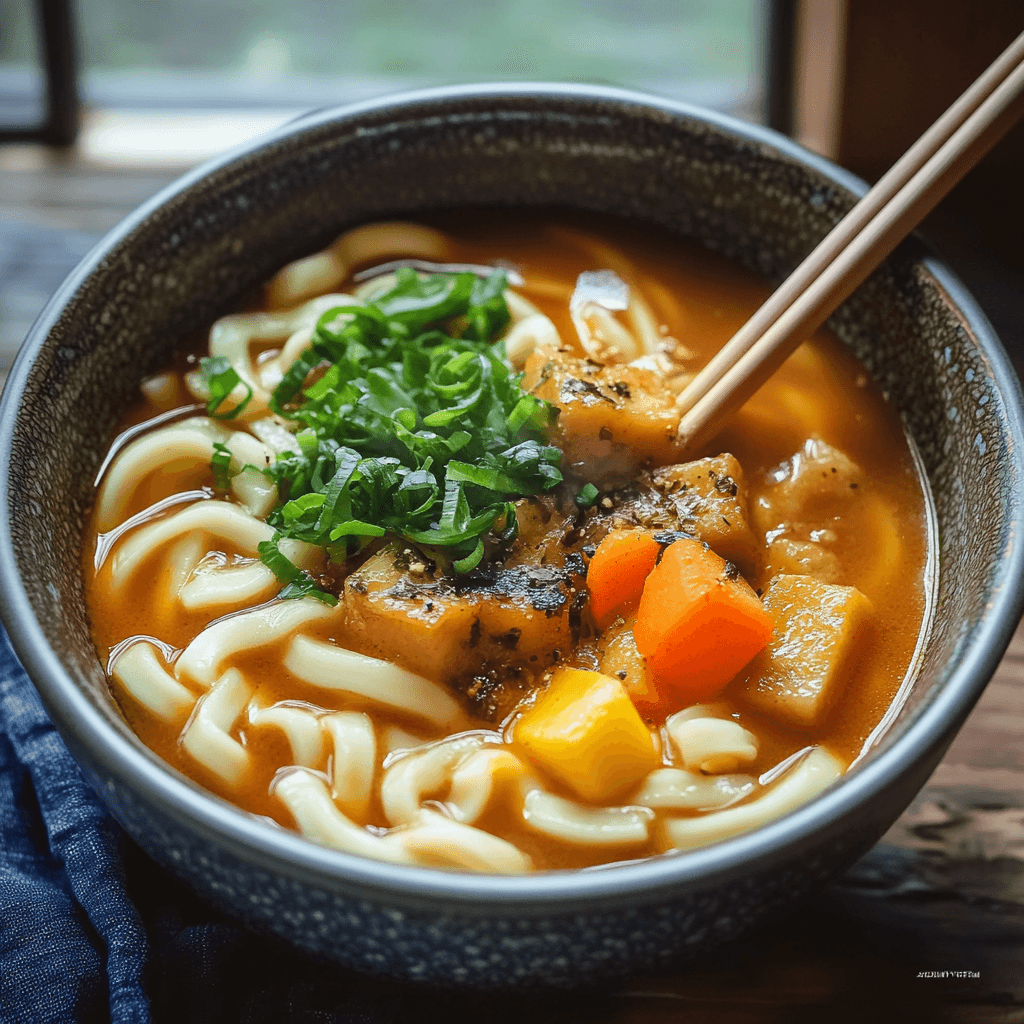
FAQs
What is Japanese Curry Udon?
Japanese Curry Udon combines thick udon noodles with savory curry sauce made from a roux base typically enriched with vegetables like carrots and potatoes along with protein options such as chicken or tofu. This comforting dish offers warmth alongside delightful textures from both noodles and hearty ingredients—making it perfect for weeknight dinners!
How long does it take to make Japanese Curry Udon?
Preparing Japanese Curry Udon takes approximately 30-40 minutes from start to finish depending on ingredient preparation speed! Cooking fresh udon noodles usually requires about 10 minutes while making the curry sauce takes around 20 minutes total after sautéing vegetables until tender-crisp—you’ll be enjoying this delicious meal in no time!
Can I freeze leftover Japanese Curry Udon?
Yes! You can freeze leftover Japanese Curry Udon easily for future meals! To do this successfully: let it cool completely before transferring into airtight containers—make sure not too much liquid remains so noodles won’t turn mushy upon reheating later on! Consume within three months for best results regarding quality preservation!
What kind of vegetables work well in this recipe?
A variety of vegetables complement Japanese Curry Udon wonderfully including carrots, potatoes bell peppers zucchini mushrooms among others! Feel free also experiment based on personal preference seasonal availability—focus on tender-crisp varieties that’ll maintain texture once cooked!
Is there a vegetarian version of this dish?
Absolutely! To create a vegetarian-friendly version simply replace any meat options used within traditional recipes with tofu tempeh seitan along additional plant-based proteins alongside stock sourced from vegetable broth instead chicken stock—it still delivers robust flavor without compromising authenticity!
Can I use instant noodles instead of udon?
While instant noodles are convenient quick options—they differ significantly from authentic udon regarding texture thickness! If you’re seeking authenticity stick closely using properly prepared fresh frozen packaging found at local stores; however if pressed for time then instant varieties may suffice though results won’t be quite identical!
Conclusion
Japanese Curry Udon (Quick and Easy Weeknight Dinner) offers an irresistible blend of flavors that’s perfect for busy evenings spent with loved ones around the dinner table! By avoiding common mistakes like overcooking vegetables or skimping on seasonings while employing useful tips such as prepping ingredients beforehand—you’ll ensure every bite delights those who share this culinary experience together!
Remember always prioritize quality ingredients like fresh produce flavorful proteins paired alongside exquisite sauces crafted from authentic roux bases tailored towards individual tastes expressed through garnishes unique preferences—all contribute towards creating unforgettable memories centered around delicious food shared among family friends alike!
As you venture into making this delectable dish reflect upon ways customize it further utilizing seasonal veggies proteins explore diverse toppings embodying spirit creativity within kitchen adventure awaits every time pot simmering away filled deliciousness excitement endless possibilities await enjoying every moment journey culinary bliss experienced home kitchen setting!

